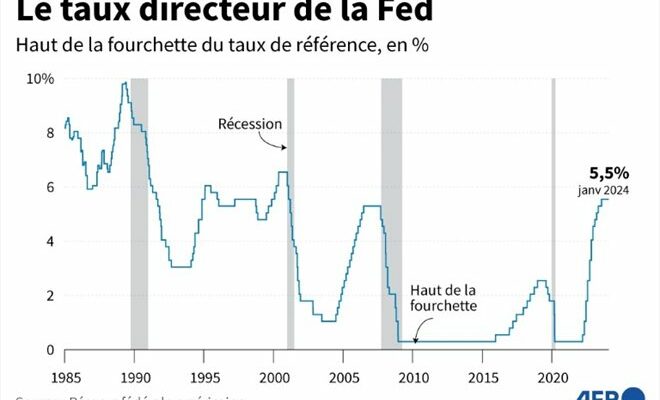A job offer in the window of a Los Angeles cafe, January 3, 2024 in California (Getty/AFP/Archives/MARIO TAMA)
Job creation in the United States has once again exceeded all expectations for the first month of 2024, blessings for President Joe Biden in the middle of the electoral campaign, but the devil may be hiding in the details.
In January, 353,000 jobs were created, the Labor Department announced on Friday, twice more than expected, and is even a little higher than December, whose data was nevertheless revised upwards.
The unemployment rate is stable at 3.7%.
“The American economy is the strongest in the world,” even proclaimed Joe Biden, who is seeking a second term in the White House.
Good news never comes alone, consumers, who have long blamed the Democratic president for soaring prices, are “now assured that inflation will continue to slow”, and their morale jumped in January to its highest level since July 2021, according to the final estimate from the University of Michigan, also released Friday.
The electoral campaign for the November presidential election is launched. Joe Biden’s main competitor on the Republican side is former President Donald Trump, who regularly praised the vigorous health of the American economy when he himself was in the White House.
– “Indicators of weakness” –
However, if certain elements show “the remarkable solidity of the job market”, there are also “worrying indicators of weakness”, nuance Julia Pollak, chief economist for the job advertisements site ZipRecruiter.
She notes in particular that “the average weekly working time has fallen to its lowest level since the recession” of 2020, linked to the Covid-19 crisis, and, before that, since 2010.

Demonstration by employees of the Los Angeles Times newspaper after announcements of layoffs, January 19, 2024 in Los Angeles, California (AFP/Archives/Patrick T. Fallon)
According to her, this is a “alarm signal” warning that “job cuts could be imminent”, because “companies generally reduce working hours before reducing payroll”.
Already, January has seen multiple announcements of layoffs, such as at the Los Angeles Times which parted ways with more than a fifth of its editorial staff, or in the courier and parcel delivery group UPS which announced the elimination of 12,000 jobs out of the company’s 500,000.
Cost cutting is the “primary driver” of layoffs, according to Andrew Challenger, vice president of consulting firm Challenger, Gray & Christmas, which released a survey on the subject on Thursday.
There are also, he points out, “broader economic trends and a strategic shift towards increased automation and the adoption of artificial intelligence in various sectors”, while the approach to the election pushes companies to anticipate “possible political changes likely to have an impact on their sectors”.
– The Fed waits on rate cuts –
Job growth in January, certainly, “was exceptional”, but this should reassure the American central bank (Fed) to be patient before starting to lower rates, comments Rubeela Farooqi, chief economist for High Frequency Economics.

The Fed’s key rate (AFP/Valentin RAKOVSKY, Samuel BARBOSA)
The Fed is in fact planning to start easing its monetary policy in 2024. This will release some ballast for households’ access to credit, and restore some purchasing power.
Its president Jerome Powell, however, judged on Wednesday “unlikely” to reach by the next meeting, in March, a sufficient “level of confidence” in the trajectory of inflation to begin rate cuts at that time.
He described a “labor market (which) remains tight, but supply and demand conditions continue to rebalance.” And “while a year ago, we thought that a certain slowdown in economic activity was necessary” to bring down inflation, now, “we are not seeking to weaken the labor market”
PCE inflation, the index favored by the Fed and which it wants to reduce to 2%, showed a change in prices excluding energy and food of 2.9% over one year in December, the lowest in almost three years.
© 2024 AFP
Did you like this article ? Share it with your friends using the buttons below.




